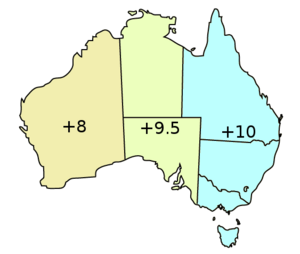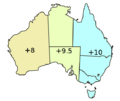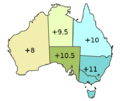Australian time zones facts for kids
Australia is a very big country, so it has three main time zones! These are called Australian Western Standard Time (AWST), Australian Central Standard Time (ACST), and Australian Eastern Standard Time (AEST). Usually, people just shorten these names to Western Standard Time (WST), Central Standard Time (CST), and Eastern Standard Time (EST).
Most of Australia's faraway islands, called external territories, have their own different time zones. Also, many parts of Australia use daylight saving time for part of the year. This means they move their clocks forward by an hour during warmer months.
Here's a quick look at Australia's main time zones:
| Official Australian Time Zones | |||
| Time Zone Name | Western Standard Time (WST) | Central Standard Time (CST) | Eastern Standard Time (EST) |
| Time Ahead of GMT | + 8:00 hours | + 9:30 hours | +10:00 hours |
| States or Territories Using It | Western Australia | Northern Territory South Australia |
Queensland New South Wales Australian Capital Territory Victoria Tasmania |
History of Australian Time Zones
Australia's three official standard time zones were first set up in February 1895. This helped make sure everyone knew what time it was across the large country.
South Australia's Unique Time
When time zones were first created, South Australia was nine hours ahead of Greenwich Mean Time (GMT). But in May 1899, they added another thirty minutes. This made their time zone nine and a half hours ahead of GMT. Some people have not liked this half-hour difference. They tried to change it in 1986 and 1994, but the changes did not happen.
Territories Keeping Time Zones
When the Australian Capital Territory became separate from New South Wales, it continued to use Eastern Standard Time. Similarly, when the Northern Territory separated from South Australia, it kept using Central Standard Time.
Special Time Zone Cases
There are a few places in Australia that have slightly different time rules:
- Broken Hill: The town of Broken Hill in far-western New South Wales uses Central Standard Time. This is different from the rest of New South Wales, which uses Eastern Standard Time.
- Lord Howe Island: This small island sets its clocks 10 hours and 30 minutes ahead of GMT.
- Central Western Standard Time: Some towns along the Eyre Highway in Western Australia use an unofficial time zone. This is called Central Western Standard Time. It is 45 minutes ahead of the official Western Australian time.
- Indian Pacific Train: The famous Indian Pacific train has its own special "train time." This time zone is used when the train travels between Kalgoorlie and Port Augusta.
Australia's Outside Territories
Australia has several islands and territories that are far away from the mainland. These places follow their own time zones. None of these outside territories use daylight saving time.
| Territory | Standard Time |
|---|---|
| Heard Island and McDonald Islands | UTC+5 |
| Cocos (Keeling) Islands | UTC+6:30 |
| Christmas Island | UTC+7 |
| Norfolk Island | UTC+11:30 |
| Australian Antarctic Territory - Mawson | UTC+6 |
| Australian Antarctic Territory - Davis | UTC+7 |
| Australian Antarctic Territory - Casey | UTC+8 |
Daylight Saving Time in Australia
Daylight saving time is when clocks are moved forward by one hour during the warmer months. This gives people more daylight in the evenings.
Where Daylight Saving is Used
South Australia, New South Wales, the Australian Capital Territory, Victoria, and Tasmania use daylight saving time every year. In these areas, daylight saving time usually starts on the first Sunday in October at 2:00 am. It ends on the first Sunday in April at 3:00 am. Sometimes, these start and end times are changed for special events, like the Olympic Games or Commonwealth Games held in Australia.
Where Daylight Saving is Not Used
The Northern Territory, Queensland, and Western Australia do not use daylight saving time. People living in the northern parts of Australia often do not like daylight saving. This is because the sun rises and sets at similar times throughout the year closer to the equator, so changing the clocks doesn't make much difference to daylight hours.
Images for kids
See also
 In Spanish: Husos horarios de Australia para niños
In Spanish: Husos horarios de Australia para niños






